
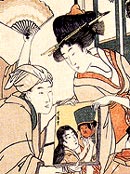
Daniel Kelly (ダニエル-ケリ)
|
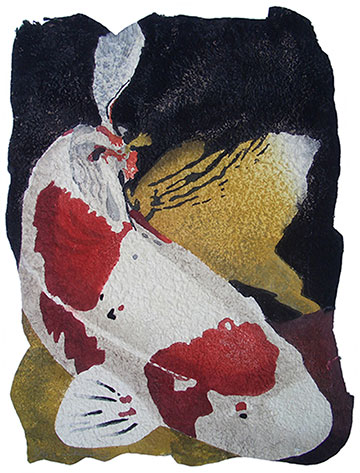 Daniel Kelly (pronounced Danieru Keri ダニエル-ケリ in Japanese), born in 1947 in Great Falls, Montana, was raised in Idaho Falls, Idaho. He received BFA and MS degrees in Oregon (University of Portland and Portland State University). He then moved to San Francisco, where he produced ceramics and blown glass before studying romantic-expressionist painting with Morton Levin (born 1923).
Daniel Kelly (pronounced Danieru Keri ダニエル-ケリ in Japanese), born in 1947 in Great Falls, Montana, was raised in Idaho Falls, Idaho. He received BFA and MS degrees in Oregon (University of Portland and Portland State University). He then moved to San Francisco, where he produced ceramics and blown glass before studying romantic-expressionist painting with Morton Levin (born 1923).
Kelly relocated to Kyoto in 1977 to study printmaking with Tokuriki Tomikichirô (徳力富吉郞 1902-2000) and has remained there ever since. Tokuriki accepted Kelly as a student for three months and then acted as an advisor for years afterward. It was from Tokuriki that Kelly learned the techniques of traditional woodblock printing.
Kelly now works in a variety of media, including woodblock prints, lithography, etching, cement-relief block prints, mixed-media prints, and painting. The latter often goes far beyond oils applied to planar surfaces, but rather incorporates wood, encaustic, bamboo mats, tatami, linen, and a variety of fibers in sculptural-like constructions. Kelly's website states, "Paintings are rendered in acrylic on hand-made Nepalese paper on three-dimensional sculpted panels that appear to change when viewed from different angles."
Often unconventional in his printmaking and paintings. Among his distinctive techniques is a method of making block prints by applying a wet-cement and polyvinyl-glue mixture to a wooden plank and sculpting it into a raised surface to hold ink for printing. A 35-year retrospective solo exhibition at the Hanga Ten Gallery, London in November 2014 was titled "Daniel Kelly: Fish out of water." He says, "Mostly, I have an idea about what I want to do and then I go out and find sources so I can make it."
His themes feature quiet landscapes, bold still lifes, portraits, carp (koi, 鲤), paper lanterns (chôchin, 提灯), and ceramic bowls. Kelly has said about portraits that, "I really believe if you are going to be depictive, ultimately the most interesting subject is people." Regarding koi, of which Kelly has made eight print designs and various paintings, "Carp have abstract expressionist paintings on their backs. That gave me an excuse to paint them." His first print of koi was "The Secret" in 1994 combining lithography and concrete relief printing on Nepalese paper. The design shown above right is titled "Red Hook," a large-format work measuring 94 x 75 mm. Kelly produced the design in 2005 using woodblock printing and hand-coloring on Thai mulberry paper in an edition of 90 (plus 20 artist's proofs, one printer's proof, and five trial proofs). It was printed by Ta-Ken and Naoko Komori at Tsumuji Studios, Kyoto, and hand-colored by Kelly in Kyoto. The audacious red splashes of color do indeed evoke expressionist forms on canvas, while the textures imparted to the surface by the thick rough paper add a slight three-dimensional touch. Kelly has said, "I prefer a paper that's difficult to work with because of the character it leaves behind."
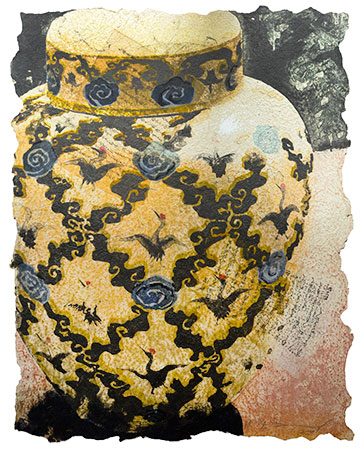 The design shown at the left is titled "Cranes," a mixed-media print comprising lithograph, woodblock, and hand-coloring on Nepalese paper with chine-collé of Edo-period book pages. The edition size was 75 (plus 15 artist proofs), with the following participants: Lithography by Chiaki Kayama at Edition Works, Tokyo; woodblock printing by Shannon Goff and Ta-Ken at Tsumuji Studios, Kyoto; and hand-coloring by Daniel Kelly in Kyoto, Japan. The print is another of the large-format works (920 x 735 mm) whose amplitude provides much of the visual impact. As with many of Kelly's designs, the irregular edges of the paper are part of the design. Here, the off-center placement and truncation of the vase avoids rigidity that might otherwise settle upon the composition. There is, as well, a liveliness in the details, particularly in the many cranes flying within the diamond shapes formed by the stylized black clouds.
The design shown at the left is titled "Cranes," a mixed-media print comprising lithograph, woodblock, and hand-coloring on Nepalese paper with chine-collé of Edo-period book pages. The edition size was 75 (plus 15 artist proofs), with the following participants: Lithography by Chiaki Kayama at Edition Works, Tokyo; woodblock printing by Shannon Goff and Ta-Ken at Tsumuji Studios, Kyoto; and hand-coloring by Daniel Kelly in Kyoto, Japan. The print is another of the large-format works (920 x 735 mm) whose amplitude provides much of the visual impact. As with many of Kelly's designs, the irregular edges of the paper are part of the design. Here, the off-center placement and truncation of the vase avoids rigidity that might otherwise settle upon the composition. There is, as well, a liveliness in the details, particularly in the many cranes flying within the diamond shapes formed by the stylized black clouds.
Kelly began making prints of Japanese paper lanterns in 1984 in New York City. The earliest among these were lithographs with chine-collé. He has gone on to make a total of 23 print editions on the subject. His design titled "Criss-cross" was first self-published in 1985 in an edition of 50 (plus 5 artist proofs). More than two decades later, in 2007, Kelly made seven trial proofs, reworking the print with collage and hand-painting to create new works. The palette is much brighter and the application through chine-collé of an Edo-period actor print added a slightly jarring note to the composition. Kelly has often applied Edo-period book pages to his prints using a chine collé method. Goodhall writes that, "The written contents of the pages are of no consequence to Kelly in his conception of a piece; rather, the varying styles and density of calligraphy or illustration play against the imagery of the overall print purely as a design element." Here, the placement of so many text pages along strong diagonals adds complexity to the design while also producing a sense of movement as though a breeze has gently lifted the lanterns and papers.
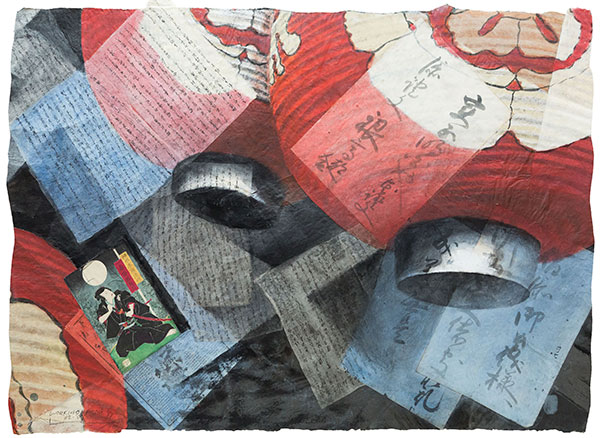 |
| Daniel Kelly: Criss-Cross, 1985 and 2007 (860 x 920 mm) Lithograph, woodblock on Japanese mulbery paper with chine-collé of Edo-period book pages; with hand-coloring |
China Bowl is one of Kelly's much-admired ceramic-bowl prints. It is self-published, but printed by Paul Mullowney at Tokugenji Press, Nara, Japan. Hollis Goodall, in her introduction to the book cited below, describes Kelly's methodology: "Kelly's approach to the bowl started with depiction of the basic ceramic form, drawing its outlines with quick, simple strokes then employing contrasts of light and dark to sculpt the hollowed-out shape. He began to play with the perceived visual distortion of the bowl's ornamented painted motifs as they curve away and out of sight of the viewer. The motifs he drew on the faces of the bowls, which he combined from details of objects observed in museums or seen in art books, were appealing to Kelly as subject matter, but played a more critical role in his compositions as vehicles for experimenting with distortion, complex layering of shapes and textures, and gestural brushwork. In the reflective surfaces of the bowls, sometimes a photographer's flash or overhead light can be detected, and in those depictions that closely follow a known masterwork, even the speed of the potter's wheel and brush are retained in Kelly's image." © 2019 by John Fiorillo
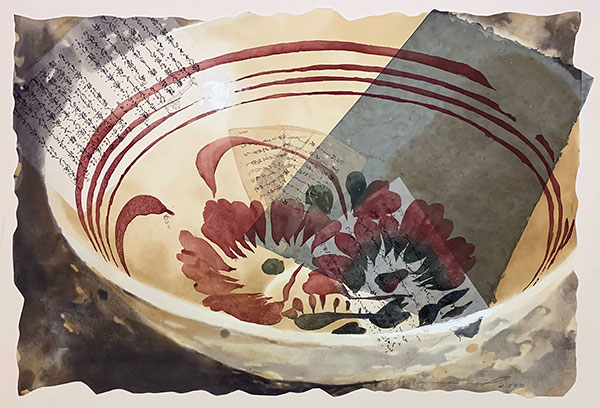 |
| Daniel Kelly: China Bowl, 2000 (600 x 890 mm) Etching with chine collé of Thai mulberry paper and Edo-period book pages; with hand-coloring |
BIBLIOGRAPHY
- Daniel Kelly: An American Artist in Japan. Tokyo/New York: Kodansha, 2010.
- "Daniel Kelly: Fish Out of Water." South Kensington, London: Hanga Ten Gallery, exhibition, Nov. 2018, video exerpts of the artist's talk (Youtube).
- "Daniel Kelly: The Secret." Kyoto: Daniel Kelly Studio, March 2007, video by John Wells.
- Hollis Goodall: "Introduction: Daniel Kelly, the Iconoclast," in: Daniel Kelly: An American Artist in Japan. Tokyo/New York: Kodansha, 2010.
Viewing Japanese Prints |